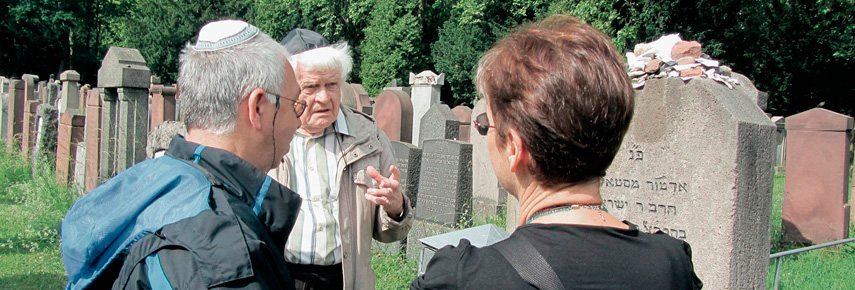BIOGRAPHICAL NOTES
Ricardo Caro
Visiting Program: 2014
Brother:
Andres Caro
Parents:
Mother: Lotte Caro, née Wachenheimer from Frankfurt
Father: Hans Kurt Caro from Berlin
Grandparents:
Grandfather: Isaak Wachenheimer
Grandmother: Johanna Wachenheimer, née Epstein
Business Premises in Frankfurt:
Untermainkai 82
- 1933 Emigration of Isaak Wachenheimer and part of his family to Denmark
- 1936 Marriage of Lotte Wachenheimer and Hans Kurt Caro in Denmark
- 1936 Emigration to Argentina
- 1940 Suicide of Isaak Wachenheimer after German invasion into Denmark
Sources:
- Projekt Jüdisches Leben in Frankfurt (PJLF): Talks with members and friends of the Caro family
- Förderverein Jüdische Geschichte und Kultur im Kreis Gross-Gerau e.V. (Hrsg.), Die Geschichte der Juden in Biebesheim, Riedstadt 1997.
- Hanne Kaufmann, Die Nacht am Øresund. Ein jüdisches Schicksal, Bleicher Verlag, Gerlingen 1994.
Photos:
- Förderverein Jüdische Geschichte und Kultur im Kreis Gross-Gerau e.V. (Hrsg.), Die Geschichte der Juden in Biebesheim, Forum Verlag, Riedstadt 1997.
- Hanne Kaufmann, Die Nacht am Øresund. Ein jüdisches Schicksal, Bleicher Verlag, Gerlingen 1994.
- Beate Klarsfeld und Serge Klarsfeld, Endstation Auschwitz. Die Deportation deutscher und österreichischer jüdischer Kinder aus Frankreich. Ein Erinnerungsbuch, Köln 2008.
- Blog von Donna Adler Swarthout
Text and Research:
Georgette Brock
Ricardo Caro
Dispersed over half of the globe
By Georgette Brock
In 2014, Dr. Ricardo Caro came to Frankfurt from Buenos Aires/Argentina to participate in the city’s visitors program for its former Jewish citizens. He was accompanied by his wife Lucia Gallo and his son Alfredo. Born in Argentina, it was his first visit in Germany, but he spoke fluent German, “because at home our family always spoke German”.
The Caro Familiy in Search of their Ancestors
Ricardo Caro’s mother Lotte was a née Wachenheimer, and the Wachenheimers had lived in Hesse for centuries. Many are descendants of Lazarus and Charlotte Wachenheimer from Biebesheim, who had eight children.
Isaak Wachenheimer married Johanna Epstein and the couple moved to Frankfurt where Isaak ran an enterprise for jewellry, gold- and silverware, located at Untermainkai 82. Ricardo Caro had wanted to see the house, but it is not there any more.
However, the trade licence in the trade files which are archivated at the Institute of Urban History registered the business as “Schmucksachenhandlung” (jewellry trade).
Isaak and Johanna Wachenheimer had five children: Rina (born in 1899), Lilly (born in 1990), Ernst (born in 1903), Else (born in 1905) and Lotte (born in 1914). When Lotte was twelve years old, her mother died and was buried on the Israelite Cemetary at Rat-Beil-Street in Frankfurt.
Emigration to Denmark
Unlike many others, Isaak Wachenheimer seems to have foreseen what was going to happen in Germany. Just before the Nazis came to power, he emigrated to Denmark with his family.where he had previously tranferred money as a precaution.. In Denmark, their lives and fates went different ways.
Rina, meanwhile married to Walter Bruchfeld, stayed in Germany with her husband and sons Franz Steffen and Edwin. Ernst fled to Barcelona, and in the wake of the Spanish civil war on to Bolivia. Else emigrated to Uruguay with her husband Julius. Lotte, the youngest, who was not even twenty years old when she left Germany, became acquainted with Hans Kurt Caro from Berlin in Denmark. He had left Berlin head over heels in 1933 after a dispute with Nazi workers at Siemens where he was an apprentice. They had threatened him: “Damned Jew, if you turn up again tomorrow, you will be dead!” Hans Kurt and Lotte married June 25, 1936 and emigrated to Argentina in the same year. Hans Kurt Caro found work with the grain export firm Dreyfuss in the town of Parana. In 1939, their son Ricardo was born there; five years later his brother Andres was born.
Only Lilly stayed in Denmark with her father together with her three children Edith, Hanne and Gerhard. Her husband, Julius Kaufmann, had gone to Palestine in 1933. They did not see him again until 1951, eighteen years later.
When Hitler’s troops occupied neutral Denmark in 1940, Isaak Wachenheimer took his own life. The inscription on the tombstone for him and his wife Johanna on the Israelite Cemetary at Rat-Beil-Street in Frankfurt therefore reads: DECEASED MAY 14, 1940, BURRIED IN KOPENHAGEN.
Dramatic Rescue of the Danish Jews
Isaak Wachenheimer’s daughter Lilly and her children remained in Denmark, because other than in the other occupied countries, the Danish Jews were not molested rightaway. But in 1943, Werner Best became Hitler’s governor there. He had already been engaged in the persecution of the Jews in France and now demanded the arrest of the 8000 Danish Jews. But when the Gestapo showed up in order to arrest the Jews during the night from October 1, to October 2, 1943, almost all of their apartments were empty. The inhabitants had been warned and hidden by Danish friends, acquaintances or complete strangers, who slipped them off to the coast of the Oeresund from where they were all ferried over to neutral Sweden by fishing boats and other small vessels in one single night. Lilly and her children survived that dramatic rescue action in the hold of a fishing-boat. Lilly’s daughter, Hanne Kaufmann, who became a writer later on, wrote a book about it.
Hanne’s twin brother Gerhard later married Lilian Rosenstock and became father of two sons, and her sister Edith (Thorson) was mother of three children. Her cousin Edwin Bruchfeld. who had survived the Holocaust in the non-occupied part of France together with his father Walter, also came to Sweden after the War, married Gudrun Goldschmidt and became father of six children who all still live in Sweden with their families.
No Escape for Rina and Franz Steffen
While Isaak Wachenheimer’s daughters Lilly, Else and Lotte escaped the Holocaust in neutral Sweden and Latin America, his eldest daughter Rina and her son Franz Steffen were hit all the harder. The Bruchfeld family had fled to France via Switzerland in 1933 and lived in Boulogne-Billancourt, a suburb of Paris. Rina was arrested in the course of a raid in 1942 and – according to the book “Endstation Auschwitz” by Beate and Serge Klarsfeld – deported to Auschwitz via Pithiviers by transport No. 14 on August 3, 1942. Her son Franz Steffen followed her by transport No. 24 on August 26, 1942.
School Visit in Oberursel
Dr. Caro spoke about his family history and the tragic end of his aunt Rina and cousin Franz Steffen to high school students in Oberursel and urged them to keep a watchful eye on life. Answering the question of a girl whether he believed that such a catastrophe could happen again, he said: “It can. It is now up to the young people, because the situation is crucial. You have to pay great attention and try to prevent another such tragedy, no matter who is affected. The world looked away then, and today it looks away with regard to Syria.”
Surprising Discovery
At the final reception by the city of Frankfurt, the Caros – including Alfredo’s wife Claudia – happened to sit at the same table as the Adler sisters and discovered in the course of the conversation that they were related to each other: Alfredo’s greatgrandfather and the greatgrandmother of the Adler sisters were siblings. Isaak Wachenheimer had had seven brothers and sisters who were all born in Biebesheim, and one of his sisters, Berta, had married a Gustav Adler from Altwiedermus in Northern Hesse.
Today, there are no Wachenheimers in Biebesheim any more. Today their descendants are dispersed over half of the globe.

